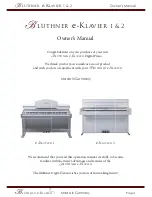
Advanced Options
41
1006232_RevD
Power—specifies the intensity of the laser stimulus of the sample.
Exposure—specifies the duration of the spectral collection period.
Averages—specifies the number of times the stimulus/collection sequence is performed during
the Scanning phase of the sample-analysis cycle.
Focal Position – specifies where the sample sits in comparison to the laser focus.
It is imperative that when building a custom library that the spectral quality of the included samples be
of the highest possible quality. For pharmaceutical applications traceability and certificates of analysis
may be required to be cGMP compliant.
Note:
Materials built into a custom library will automatically be placed into the Master Library.
When building a custom library the user will have the option of specifying the results returned on the
instrument. The settings for Verify (Pass/Fail) or Identification are set at the same time as other
instrument parameters by the Administrator and cannot be adjusted in the application later on by other
users. The Administrator will set the appropriate conditions for each application when the custom
application is created. At the same time, the Administrator will collect and add materials to the
application and/or create new libraries. The following instructions for Verification and Identification of
Substances presumes that any custom applications or libraries have already been built and are on the
instrument ready for the user.
Verification of Known Substances
Verification applications confirm that a sample is the expected substance. The custom application uses
the pre-defined instrumental settings and prompts the user for the sample to be tested. The sample
must be present in the library already. After selecting the sample, you can start the scan.
The instrument scans the sample and then compares the spectra generated to the spectral profile of the
library material. If the two spectra have a correlation above the correlation cutoff set for a Match in the
instrument parameters, the result screen will return a green Pass. If the instrument determines that
the sample does not match selected substance within the set correlation Match the result returned will
be a red Fail. The instrument will then start a discovery search in the Master Library.
If one or more matches are found in the Master Library as set in the Max # of Search Results, and if
these have correlations greater than the correlation cutoff, then these results will be returned in the
scan results. Once the verification application’s scan cycle is complete, the instrument generates a scan
results that includes:
Color coded results header:
Green for Pass.
Red for Fail.
Colored graph with both the detected spectrum and the spectrum from the selected profile.
Library match data (when Max # of Search Results is enabled):
For scans that return Pass—Substance data listed in the selected profile.
For scans that return Fail —Substance data from the library profile with the closest
spectrum.
For applications with a Max # of Search Results setting greater than 0—Substance names
and data listed in up to five library profiles.
Содержание Progeny
Страница 1: ...1006232_RevD 3 Progeny and Progeny LT Analyzer User Manual Rev D...
Страница 74: ...Advanced Options 67 1006232_RevD Figure 40 Sample Application...
Страница 106: ...Export and Import Settings 99 1006232_RevD Figure 70 Progeny Settings Screen...
Страница 111: ...Appendix B Nose Cone Positions 104 1006232_RevD Appendix B Nose Cone Positions...
















































